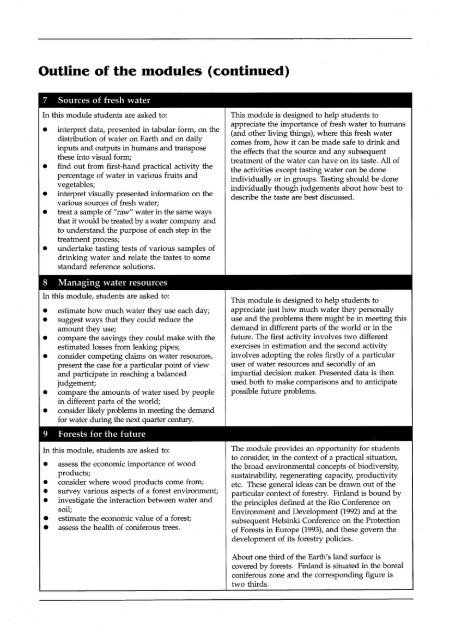UNESCO resource kit - science and technology educa...
UNESCO resource kit - science and technology educa...
UNESCO resource kit - science and technology educa...
Create successful ePaper yourself
Turn your PDF publications into a flip-book with our unique Google optimized e-Paper software.
Outline of the modules (continued)<br />
7 Sources of fresh water<br />
In this module students are asked to:<br />
• interpret data, presented in tabular form, on the<br />
distribution of water on Earth <strong>and</strong> on daily<br />
inputs <strong>and</strong> outputs in humans <strong>and</strong> transpose<br />
these into visual form;<br />
• find out from first-h<strong>and</strong> practical activity the<br />
percentage of water in various fruits <strong>and</strong><br />
vegetables;<br />
• interpret visually presented information on the<br />
various sources of fresh water;<br />
• treat a sample of "raw" water in the same ways<br />
that it would be treated by a water company <strong>and</strong><br />
to underst<strong>and</strong> the purpose of each step in the<br />
treatment process;<br />
• undertake tasting tests of various samples of<br />
drinking water <strong>and</strong> relate the tastes to some<br />
st<strong>and</strong>ard reference solutions.<br />
8 Managing water <strong>resource</strong>s<br />
In this module, students are asked to:<br />
• estimate how much water they use each day;<br />
• suggest ways that they could reduce the<br />
amount they use;<br />
• compare the savings they could make with the<br />
estimated losses from leaking pipes;<br />
• consider competing claims on water <strong>resource</strong>s,<br />
present the case for a particular point of view<br />
<strong>and</strong> participate in reaching a balanced<br />
judgement;<br />
• compare the amounts of water used by people<br />
in different parts of the world;<br />
• consider likely problems in meeting the dem<strong>and</strong><br />
for water during the next quarter century.<br />
9 Forests for the future<br />
In this module, students are asked to:<br />
• assess the economic importance of wood<br />
products;<br />
• consider where wood products come from;<br />
• survey various aspects of a forest environment;<br />
• investigate the interaction between water <strong>and</strong><br />
soil;<br />
• estimate the economic value of a forest;<br />
• assess the health of coniferous trees.<br />
This module is designed to help students to<br />
appreciate the importance of fresh water to humans<br />
(<strong>and</strong> other living things), where this fresh water<br />
comes from, how it can be made safe to drink <strong>and</strong><br />
the effects that the source <strong>and</strong> any subsequent<br />
treatment of the water can have on its taste. All of<br />
the activities except tasting water can be done<br />
individually or in groups. Tasting should be done<br />
individually though judgements about how best to<br />
describe the taste are best discussed.<br />
This module is designed to help students to<br />
appreciate just how much water they personally<br />
use <strong>and</strong> the problems there might be in meeting this<br />
dem<strong>and</strong> in different parts of the world or in the<br />
future. The first activity involves two different<br />
exercises in estimation <strong>and</strong> the second activity<br />
involves adopting the roles firstly of a particular<br />
user of water <strong>resource</strong>s <strong>and</strong> secondly of an<br />
impartial decision maker. Presented data is then<br />
used both to make comparisons <strong>and</strong> to anticipate<br />
possible future problems.<br />
The module provides an opportunity for students<br />
to consider, in the context of a practical situation,<br />
the broad environmental concepts of biodiversity,<br />
sustainability, regenerating capacity, productivity<br />
etc. These general ideas can be drawn out of the<br />
particular context of forestry. Finl<strong>and</strong> is bound by<br />
the principles defined at the Rio Conference on<br />
Environment <strong>and</strong> Development (1992)<strong>and</strong> at the<br />
subsequent Helsinki Conference on the Protection<br />
of Forests in Europe (1993),<strong>and</strong> these govern the<br />
development of its forestry policies.<br />
About one third of the Earth's l<strong>and</strong> surface is<br />
covered by forests. Finl<strong>and</strong> is situated in the boreal<br />
coniferous zone <strong>and</strong> the corresponding figure is<br />
two thirds.

















